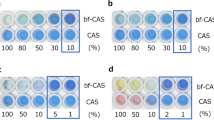Abstract
Molybdenum-reducing activity in the heterotrophic bacteria is a phenomenon that has been reported for more than 100 years. In the presence of molybdenum in the growth media, bacterial colonies turn to blue. The enzyme(s) responsible for the reduction of molybdenum to molybdenum blue in these bacteria has never been purified. In our quest to purify the molybdenum-reducing enzyme, we have devised a better substrate for the enzyme activity using laboratory-prepared phosphomolybdate instead of the commercial 12-phosphomolybdate we developed previously. Using laboratory-prepared phosphomolybdate, the highest activity is given by 10:4-phosphomolybdate. The apparent Michaelis constant, K m for the laboratory-prepared 10:4-phosphomolybdate is 2.56 ± 0.25 mM (arbitrary concentration), whereas the apparent V max is 99.4 ± 2.85 nmol Mo-blue min−1 mg−1 protein. The apparent Michaelis constant or K m for NADH as the electron donor is 1.38 ± 0.09 mM, whereas the apparent V max is 102.6 ± 1.73 nmol Mo-blue min−1 mg−1 protein. The apparent K m and V max for another electron donor, NADPH, is 1.43 ± 0.10 mM and 57.16 ± 1.01 nmol Mo-blue min−1 mg−1 protein, respectively, using the same batch of molybdenum-reducing enzyme. The apparent V max obtained for NADH and 10:4-phosphomolybdate is approximately 13 times better than 12-phoshomolybdate using the same batch of enzyme, and hence, the laboratory-prepared phosphomolybdate is a much better substrate than 12-phoshomolybdate. In addition, 10:4-phosphomolybdate can be routinely prepared from phosphate and molybdate, two common chemicals in the laboratory.




Similar content being viewed by others
References
Davis, G. K. (1991). In E. Merian (Ed.) In metals and their compounds in the environment, occurrence, analysis and biological relevance pp. 1089–1100. Weinheim: VCH.
Neunhäuserer, C., Berreck, M., & Insam, H. (2001). Water, Air and Soil Pollution, 128, 85–96.
Yong, F. S. (2000). Mamut copper mine—The untold story. The National Seminar On The Malaysian Minerals Industry “Minerals: Underpinning yesterday’s needs, today’s development and tomorrows’s growth” 22nd to 24th June 2000, Pacific Sutera Hotel, Kota Kinabalu, Sabah, Malaysia.
Levine, V. E. (1925). Journal of Bacteriology, 10, 217–263.
Capaldi, A., & Proskauer, B. (1896). Zeitschr. f. Hyg. u. Infektionskrankh., 23, 452–474.
Jan, A. (1939). Bulletin des Sciences Pharmacologiques, 46, 336–339.
Marchal, J. G., & Gerard, T. H. (1948). Travaux du Laboratoire de microbiologie de la Faculté de Pharmacie de Nancy, 16, 11–23.
Woolfolk, C. A., & Whiteley, H. R. (1962). Journal of Bacteriology, 84, 647–658.
Bautista, E. M., & Alexander, M. (1972). Soil Science Society of America Proc., 36, 918–920.
Campbell, M. A., Campbell, A. D., & Villaret, D. B. (1985). Proceedings of the National Academy of Sciences of the United States of America, 82, 227–231.
Sugio, T., Tsujita, Y., Katagiri, T., Inagaki, K., & Tano, T. (1988). Journal of Bacteriology, 170(12), 5956–5959.
Yong, N. K., Oshima, M., Blake, R. C., & Sugio, T. (1997). Bioscience, Biotechnology, and Biochemistry, 61, 1523–1526.
Lee, J. D. (1977). Concise inorganic chemistry. New York: Reinhold.
Sidgwick, N. V. (1984). The chemical elements and their compounds. Oxford: Clarendon.
Ghani, B., Takai, M., Hisham, N. Z., Kishimito, N., Ismail, M. I. A., Tano, T., et al. (1993). Applied and Environmental Microbiology, 59, 1176–1180.
Kazansky, L. P., & Fedotov, M. A. (1980). Journal of the Chemical Society, Chemical Communications, 13, 644–647.
Munch, J. C., & Ottow, J. C. G. (1983). Environmental Biogeochemistry, Ecological Bulletin (Stockholm), 35, 383–394.
Shukor, M. Y., Syed, M. A., Lee, C. H., Karim, M. I. A., & Shamaan, N. A. (2002). Malaysian Journal of Biochemistry, 7, 71–72.
Ariff, A. B., Rosfarizan, M., Ghani, B., Sugio, T., & Karim, M. I. A. (1997). World Journal of Microbiology & Biotechnology, 13, 643–647.
Shukor, M. Y., Lee, C. H., Omar, I., Karim, M. I. A., Syed, M. A., & Shamaan, N. A. (2003). Pertanika, Journal of Science and Technology, 11(2), 261–272.
Glenn, J. L., & Crane, F. L. (1956). Biochimica et Biophysica Acta, 22, 111–115.
R. M. C. Dawson, D. C. Elliott, W. H. Elliott, & K. M. Jones (Eds.) (1969). Data for biochemical research. Oxford: Clarendon.
Bradford, M. (1976). Analytical Biochemistry, 72, 248–252.
Shukor, M. Y., Shamaan, N. A., Syed, M. A., Lee, C. H., & Karim, M. I. A. (2000). Asia Pacific Journal of Molecular Biology Biotechnologies, 8(2), 167–172.
Killefer, D. H., & Linz, A. (1952). Molybdenum compounds; Their chemistry and technology. New York: Interscience.
Author information
Authors and Affiliations
Corresponding author
Rights and permissions
About this article
Cite this article
Shukor, M.Y., Rahman, M.F.A., Shamaan, N.A. et al. An Improved Enzyme Assay for Molybdenum-Reducing Activity in Bacteria. Appl Biochem Biotechnol 144, 293–300 (2008). https://doi.org/10.1007/s12010-007-8113-z
Received:
Accepted:
Published:
Issue Date:
DOI: https://doi.org/10.1007/s12010-007-8113-z




